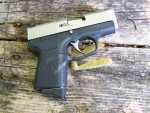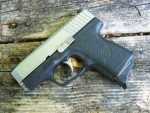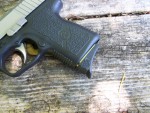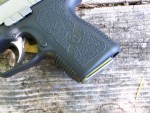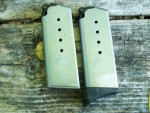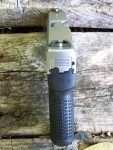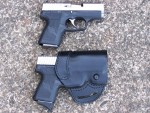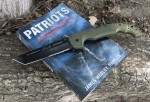There was a time, many years back, when some of the first double action only (DAO) semi-auto pistols started appearing on the market. I still remember the first S&W DAO pistols, and I tested quite a few of them, and just didn’t care for the ovey long trigger pull. I could have that on a revolver! To be sure, many of the first DAO pistols that arrived were really lacking in the trigger pull department; besides being long, some overly long, many had a hitch in their “git-along”. They were gritty, with humps and lumps along the entire trigger pull. They were not what I was looking for. Still, I owned quite a few and wrote more than a few articles about these guns. I remember one DAO pistol, the Colt All American 2000. It came in two flavors; one with a polymer frame, which was all the rage, and one with an aluminum frame. For whatever reason, the aluminum framed version had a much smoother trigger pull that was long but very smooth. The polymer framed version had a horrible trigger pull. The Colt All American 2000 is relegated to collector’s status these days, if you can find one. We won’t even go into the disassembly and reassembly of the 2000. It was a nightmare, to say the least.
We also have the GLOCK line-up for DAO handguns. Without a doubt, their trigger pull is “different” to say the least. Most describe it as “mushy”, and I have to agree. Still, their guns are more than accurate and still the most seen handgun in law enforcement holsters. The simplicity of the GLOCK is one of the selling points. Depending on who you talk to, the GLOCK has 33 or 34 parts, and take-down is as easy as can be. Still, the trigger pull isn’t the best.
Some years ago, I read about Kahr Arms. Like all gun makers, they only had one or two handguns that they were manufacturing at the time, and they hand aluminum frames. Still, everything I read about them by other gun writers claimed they had the best DAO trigger pull ever. Many described it as the Rolls Royce of DAO trigger pulls. My local gun shop at the time, never got a Kahr in, and I longed for one. I was determined to put the hype to rest, no gun has a trigger pull “that” good, according to my thinking. However, after moving from Eastern Oregon and the high desert area back to the wet side of the state, which is now experiencing drought and one of the hottest summers on record, I found a new gun shop to haunt. Wouldn’t you know it; one of the first guns I bought from them was a Kahr Arms 9mm with an aluminum frame, and it even came with a custom leather belt holster.
I’ve got to admit, the Kahr had one of the best, if not “the” best, DAO trigger pull I’ve ever experienced, and that includes some really outstanding double action trigger pulls on revolvers. I’ve done more than my share of trigger jobs on revolvers over the years, and none were as good as the trigger pull on the Kahr. I became a huge fame of Kahr handguns, and I own more than a few. Every single one has the same outstanding trigger pull that is buttery smooth, longish, but smooth and with no hitch it the git-along. It’s a smooth pull all the way through as you activate the trigger.
I’ve lost count of the number of Kahr handguns they are producing, in various calibers and sizes. However, I believe it is close to a hundred different models in everything from .380 ACP, all the way up to .45ACP, with more new models on the way all the time. For this article, I tested the Kahr CM40. Kahr sent me a brand new sample, to go along with my well-used CM40, so I did a side-by-side comparison of the two guns in my testing.
The CM40 is one of the “economical” versions in the Kahr line-up. Some of us don’t need some of the fancier features, like a machined slide stop, compared to one Metal Injection Molded, or a barrel that has conventional rifling, instead of match grade polygonal barrels. After all, in my humble thought process, these little guns are best reserved for up-close and person self-defense, not long range target shooting. And, I couldn’t care less how the Kahr name and logo are placed on the slide; whether machined or roll marked, it makes no difference to me.
The striker-fired CM40 holds 5-rds in the magazine and one in the chamber. That should be enough for most folks, and if you take my advice you should ALWAYS carry at least one spare magazine anyway, just in case. The barrel is 3.1-inches long, about as short as they can be for reliable functioning. The overall length is 5.47 inches and high is 4.0 inches. This baby is small. The slide width is .94 inches. The little CM40 only weighs 15.8 ounces without the magazine. The frame is textured, rough texture on the grip area, for a sure hold on the gun. The slide is brushed stainless steel with a white dot front sight and a white bar on the rear sight. The gun only comes with one magazine, so please get at least one spare. Right now, Kahr is running a summer special; if you purchase any of their handguns with a “C” (CM or CW) in the designation, you can get one free magazine. Take advantage of this!
The only operating features on the CM40 is the slide lock, magazine release, and the trigger. The “safety” is the one between your ears, so keep your finger off the trigger until your sights are on the target. It’s real simple. Yes, there are internal passive safeties to prevent the gun from firing if dropped. You have to simply pull the trigger, all the way through, before the gun will fire. As to the texturing on the grip frame, I like it a bit rough. However, on both my CM40s, I found it too “aggressive” to my liking, and so I took some fine sandpaper to it to take off the fine points. That only took a few seconds. The .40 S&W round has some serious recoil in this little pistol, and I found it abrading my hand after long shooting sessions.
The polymer frame features stainless steel inserts embedding in the frame, and the slide rides along those inserts smoothly. As an aside, Kahr holds no less than seven patents on their own guns, resulting in benefits not found on any other handguns. Some have copied and been sued by Kahr. One other thing worth note is the barrel feed ramp. It is offset to one side, allowing the trigger bar attachment to be off to the side, thus allowing the barrel to sit lower in the frame, thus lower in the hand for more control. Unlike some other small framed handguns that state that they are only good for shooting “X” number of rounds during the life of the gun, Kahr doesn’t restrict you on this. You can shoot all you want, and the gun is covered by Kahr’s limited lifetime warranty. I wouldn’t want to go out and purchase a firearm that comes with the claim that they are only good for shooting “X” number of rounds before they wear out. Plus, Kahr states you can even shoot +P ammo through their guns! (I have more on this shortly.)
Kahr states, in their owner’s manual, that you should fire at least 200 rds through their guns before you consider carrying them for self-defense. Why? Well, their guns are tightly fit, and many other gun companies state the same thing, which is instruction to give the gun a good break-in period. My own personal CM40 took close to 200-rds to break in before it worked 100% of the time. The new sample I received from Kahr worked right out of the box with no problems for the most part.
The first thing I did, with both of the CM40s, was add the Pearce Grip magazine floor plate on the magazines. I call them “pinky catchers” because they “catch” your pinky finger. The 5-rd mags that came with the guns allowed my pinky finger to just dangle there, or I would try to curl it under the magazine. For $9.95 the Pearce mag adaptor is the way to go, and it only adds a tiny bit to the overall height of the gun. It is a “must have” accessory in my book for the CM40. It makes the gun feel all that much better in the hand.
I had a decent selection of ammo to test. From Black Hills Ammunition I had their new 155-gr JHP load, which is always a great performer, their 10-r FMJ remanufactured load, and their 140-gr Barnes all-copper TAC-XP hollow point load. From Buffalo Bore Ammunition I had their Heavy 155-gr JHP +P load, their 200-gr Hard Cast Outdoorsman load, and their 140-gr Barnes all-copper, TAC-XP hollow point load. I also had some miscellaneous mixed ammo that I used in my testing that included some reloads and some very old loads.
My accuracy testing was conducted at 15-yards, standing, using a two-hand hold with no rest. This is a very small handgun, meant for up-close serious self-defense. I will say that the Buffalo Bore 155-gr JHP +P load is one that will get your attention right away in the little CM40. Wow! It’s not a load you want to shoot much of during one shooting session; the recoil was punishing. Then again, we are talking about a sub-compact handgun, shooting the .40S&W load that does recoil quite a bit even in full-sized guns. I like the Buffalo Bore 125 and 140 Barnes loads, which are outstanding self-defense loads. They penetrate deeply, mushroom open, and stay together. The Buffalo Bore 200-gr Hard Cast Outdoorsman load would not function in either one of my CM40s, period! Looking over the Buffalo Bore website, and in a conversation with Tim Sundles, who owns Buffalo Bore, it states on their website that this round doesn’t function reliably in the CM40. Sundles said these rounds are made to SAAMI specs, too. You can find 99 types of ammo that will function in a gun, but the 100th type won’t. Sooner or later, you will run across a load that won’t function in any handgun. It’s as simple as that. It’s not the fault of the gun or the ammo. It’s just the way it is.
The Black Hills loads functioned 100% of the time. The 155-gr JHP load is one to consider for self-defense, and I’ve used this round for years in my carry guns. The 180-gr FMJ remanufactured loads are a great target practice load, too. The Black Hills 140-gr Barnes load, using the same bullet as the Buffalo Bore load was outstanding. It is moving along a bit slower than the Buffalo Bore load, and both CM40s preferred this round over all the others tested for accuracy. If I did my part, I could get 3-inch groups at 15-yards from both Kahr’s. That’s outstanding for such a short barrel and such a little gun. It just goes to show that you need to experiment with different loads in your guns to see which ones function 100% of the time and which gives you the best accuracy. The Buffalo Bore 140-gr Barnes load is moving faster, with more velocity, than the Black Hills 140-gr Barnes load, yet the Black Hills load was more accurate, and both CM40s seems to operate a bit smoother with the Black Hills load. Oh, to be sure, there was nothing wrong with the Buffalo Bore 140-gr Barnes load. I use this one a lot, but the CM40s liked the Black Hills load a little better. None of the loads tested exceeded 4-inches at 15-yards, so long as I did my part.
I will say, the CM40 does have quite a bit of recoil, and you must really have a firm grip on the gun at all times; if you limp wrist the gun, you will have malfunctions– either expended rounds won’t fully eject or the next round in the mag won’t fully chamber. This is a training issue. The gun recoils a lot, so make sure you have a firm hold on the gun. I intentionally held both guns a bit loose in my hand when firing as a test, and sure enough they would malfunction. While holding the guns firmly, I had no problems.
Blackhawk Productssent me their Leather Compact Askins belt holster to carry the CM40 in, and this baby is just made for the CM40 and other similar sized Kahr’s. The gun rides high and tight to your side. I also requested one of their ankle holsters, but it is on back order. I would like to carry the CM40 as a back-up gun to whatever my main gun is, and an ankle holster is the way to go. However, I’d have no problem carrying a CM40 in the Blackhawk Askins belt holster with at least one spare mag and probably two as my one and only self-defense handgun.
If you’re new to handgunning and would like to carry the CM40, I would steer you to their CM9. It’s the same gun in 9mm; it is much easier to control, especially in rapid-fire. The CM40 demands a strong and firm grip, and it really does recoil quite a bit. Without a lot of practice, you might encounter some malfunctions, which is something you don’t want or need in a life or death showdown. So, go with the CM9 if you find the recoil prohibitive in the .40S&W caliber. With a good JHP bullet, the 9mm will get the job done, and in the CM9 you have 6-rds in the mag instead of just 5-rds, like the CM40 carries.
I don’t know that I’d care to have any other sub-compact carry gun smaller than the CM40. The CM40 recoils more than enough for my liking, and besides if you go smaller or lighter, there is all that much more chance you’ll have more malfunctions and recoil will really turn you off. However, if you can handle the recoil in a CM40, then by all means get your hands on one. It is one potent self-defense pistol. You can usually find the CM40 for under $400 in my neck of the woods, and that’s quite a bargain for such a high-class handgun that is easy to conceal.
– Senior Product Review Editor, Pat Cascio

